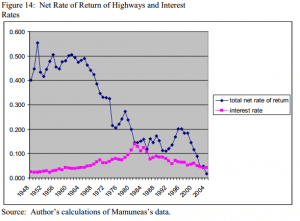If you have been reading my recent posts at Forward Lookout, you are aware that I have been sending out a series of open records requests to state office holders who claim that increased infrastructure spending grows the economy. I recently received a response from Senator Jennifer Shilling’s Office to one such request.
Like the other responses I have received, Shilling’s response indicated her office had no records that demonstrated the net return on investment for the highway expansion projects in the budget approved by the Joint Finance Committee. Unlike other responses, Shilling’s staff provided a reference to a federal study on the effectiveness of the 2009 stimulus as it relates to transportation, citing this section:
“A modern and effective transportation infrastructure network is both necessary for the economy to function and a prerequisite for future growth.”
The referenced section cites two summaries of findings, Munnell (1992) and Fernald (1999) as the basis for the claim of benefit.
First, from the conclusion section of Munnell (1992):
“This is an area ripe for research that could have important policy implications. Researchers should focus on explaining the variations in the coefficients by level of government, disentangling the causation question, and examining the cointegration issue.”
But Munnell notes:
“Aggregate results, however, cannot be used to guide actual investment spending. Only cost-benefit studies can determine which projects should be implemented.”
Elsewhere in Munnell we find:
“cost-benefit studies reported by the Congressional Budget Office (1988) indicate that the return to projects designed to maintain the average condition on the federal highway system could be as high as 30 to 40 percent.”
Note that this is about maintaining the average condition of the federal highway system, not expanding state highways.
Fernald (1997 – I found no 1999) addresses many the needed areas of research from Munnell. The 1997 paper does suggest there are direct benefits to certain sectors of the economy, but goes on to state:
“…the data seem most consistent with a story in which the massive road-building of the 1950s and 1960s offered a one-time boost to the level of productivity, rather than a path to continuing rapid growth in productivity”
and
“…when road growth rises, productivity growth tends to rise relative to the average in vehicle-intensive industries and fall in non-vehicle-intensive industries”
Not mentioned in the 2014 stimulus report is a 2009 summary of studies of the return on highway investment that show continued declines in returns since 1999:
My conclusion from this is that Wisconsin’s legislators need to place more emphasis on the state-wide net economic benefits of highway expansions. Wisconsin has a bit higher percentage of vehicle-intensive industries (25% in Wisconsin compared to 20% nationally), so there may be a slight net benefit for the state for some highway expansions, but we don’t really know because contrary to Munnell’s recommendation, the state does not perform a comprehensive cost-benefit analysis on any of its projects. WISDOT uses economic impact methodology formulated in the 1980’s that only counts near-corridor effects and neglects to count the kind of negatives outlined in Fernald.
I still have an open records request in to Assembly Speaker Robin Vos’ office targeted at backing data for remarks he made that suggests “highway spending is the way to grow the economy.” I will post an update if/when I get a response.





